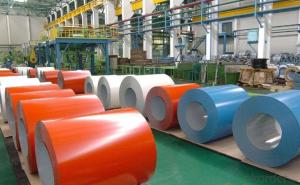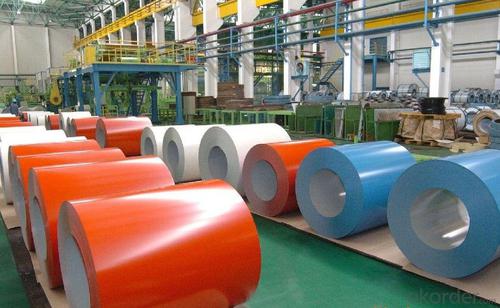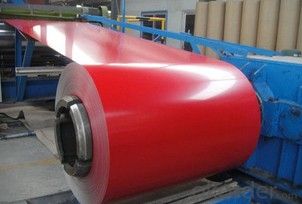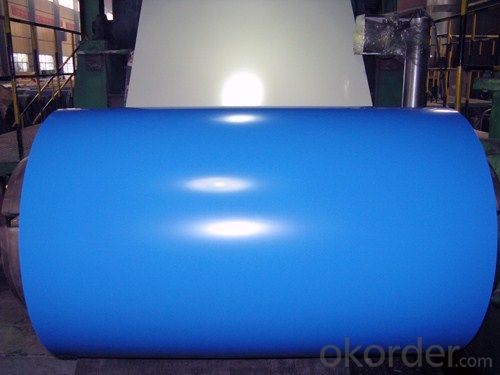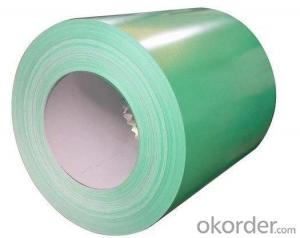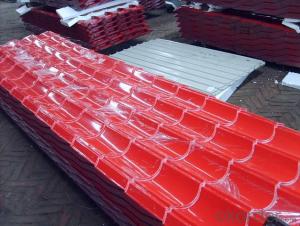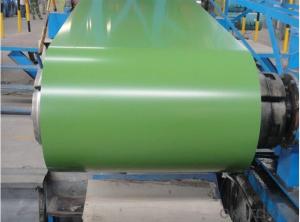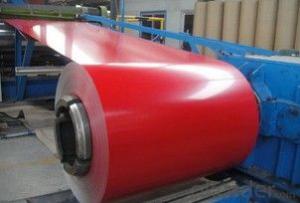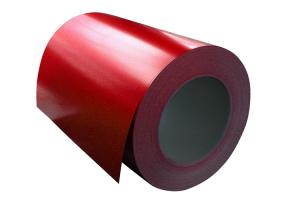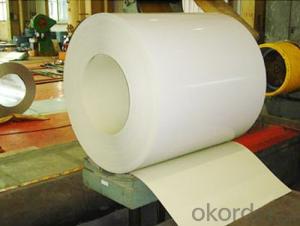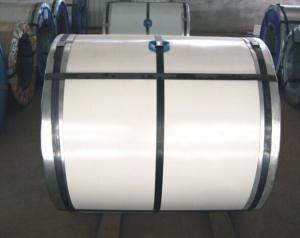PRE-PAINTED GALVANIZED STEEL COIL WITH HIGH QUALITY
- Loading Port:
- Tianjin
- Payment Terms:
- TT OR LC
- Min Order Qty:
- 25 m.t.
- Supply Capability:
- 5000 m.t./month
OKorder Service Pledge
OKorder Financial Service
You Might Also Like
Painting steel is the product based on the metal sheet, of which surface is finally installed of the plastic film(PVC, PE) IN addition to being firstly covered with the coating and printed ink in. The coated layer of painting steel plate consists of chemical and filming layer, primer coated layer, pattern printed layer and surface coated layer. The top and back coating shall generally be the weatherproof paint, as well can be the application of the paint with special capabilities such as stain-resistant, self cleaning capability, high thermal resistance, antistatic capability, sterilizing capability, finger-print prevention and etc.
With GI(aluzinc) as base metal, after pretreatement(degrease and chemical treatment)and liquid dope with several layers of color, then after firing and cooling, finally the plate steel is called pre-painted galvanized (aluzinc)steel. Pre-painted galvanized steel is good capable of decoration, molding, corrosion resistance. It generally displays superior workability, durability and weather resistance.
Available specification:
PAINTING STEEL | |
BASE MATERIAL | HDGI, ALUZINC,CR |
GRADE | SGCC, DX51D,ASTMA653,EN10142,S350GD |
THICKNESS | 0.17-1.0mm |
WIDTH | 600-1250mm |
ZINC COATING | 60-200g/㎡ |
PAINT | PE,PVDF,SMP,HDP |
COILED | 508mm |
COIL WEIGHT | 3-6mt |
We can supply customers' with different specifications of the highest quality and lowest price.
Sincerely welcome to contact us for the future details if any item interest you ,and we will make every effort to assure that your requirements will be satisfied ,and we hope to establish long-term business relations with you on the basis of the equality and mutual benefit.
We are waiting for your feedback.
- Q: How are steel coils recycled?
- Steel coils are recycled by first being collected and transported to a recycling facility. They are then processed to remove any impurities or contaminants, such as coatings or oils. The coils are then shredded into smaller pieces and melted down in a furnace. The molten steel is then molded into new coils or other steel products, ready to be used again in manufacturing processes.
- Q: it isn't a SIGG water bottle or any other brand, as it's from thingsengraved what I'm wondering is, is this just as good as a SIGG water bottle, or is there any difference?
- Should be OK- that's reputable vendor. Suggest initial flush insides with very mild acid (fill ~20% with mild vinegar, Pepsi, etc., then shake 1 minute) then rinse 2 times, then look inside to confirm it looks clean.
- Q: I got a muzzy carp point arrow and its head is steel with 1.7% carbon, its used in the water. Will i have to dry it after every use or is it stainless. Thanks
- Stainless steel is not rust proof. it's just rust resistant. It will rust. It just takes much longer to do so... So, yes, I'd dry it well after use, and even consider wiping it with a cloth containing a very lite coating of oil.
- Q: What are the common coil widths and thickness combinations available for steel coils?
- The steel coils available in the market come in various combinations of coil widths and thicknesses, depending on the specific requirements and industry standards. While there are some standard sizes commonly found, there is also the option for custom widths to cater to specific project needs. In terms of coil widths, the market offers a range of standard sizes, with the most common ones falling between 600mm and 2000mm. These widths find extensive use in industries like automotive, construction, and manufacturing. Nevertheless, it is possible to obtain custom widths tailored to the requirements of a particular project. Regarding thickness combinations, steel coils are typically available in a variety of thicknesses. The most widely used thicknesses for steel coils fall within the range of 0.4mm to 3mm. However, it is also possible to obtain thicker or thinner options depending on the specific application. It is important to bear in mind that these standard sizes and thickness combinations may vary depending on factors such as the specific steel grade, manufacturing process, and the capabilities of the supplier. To ensure the availability of the desired coil widths and thickness combinations, it is always advisable to discuss the required specifications with the supplier or manufacturer.
- Q: What are the common industry standards for steel coils?
- The common industry standards for steel coils vary depending on the region and specific application. However, there are several widely recognized standards that are commonly used in the steel industry. One of the most commonly referenced standards for steel coils is the American Society for Testing and Materials (ASTM) standard. ASTM has developed a wide range of specifications for different types of steel coils, such as hot-rolled, cold-rolled, and galvanized coils. These specifications outline various mechanical and chemical properties that the steel must meet, as well as dimensions, tolerances, and testing requirements. In addition to ASTM, other international organizations such as the International Organization for Standardization (ISO) and the European Committee for Standardization (EN) have also established standards for steel coils. ISO standards, such as ISO 3574 and ISO 5952, provide guidelines for the general requirements, dimensional tolerances, and mechanical properties of steel coils. Similarly, EN standards, such as EN 10130 and EN 10131, specify the characteristics and tolerances for cold-rolled steel coils. Furthermore, industry-specific organizations and associations may have their own standards for steel coils. For example, the American Iron and Steel Institute (AISI) has developed specific standards for different types of steel products, including coils. These standards cover various aspects such as chemical composition, mechanical properties, and surface finish. It is important to note that steel coil standards can also be determined by the end-use application. Industries such as automotive, construction, and manufacturing may have specific requirements that go beyond the general standards. In such cases, customers and manufacturers may refer to industry-specific standards or work together to define custom specifications. Overall, while there are several common industry standards for steel coils, it is crucial to consult the specific standards and requirements applicable to the region and application in question to ensure compliance and quality.
- Q: I'm not sure.Alloy stainless steel 308 series.
- Stainless steel is one of the safest things to cook on, because it doesn't release metal particles into your food.
- Q: I want to hear from those who own a scandium revolver. I know that scandium makes for a much lighter gun than steel, but how do they hold up durability-wise? Is their lifespan shorter than a comparable steel revolver?
- Yes, they are as durable as steel and lighter than aluminum, but they amplify the recoil when firing due to its light weight.
- Q: How are steel coils used in the manufacturing of fuel systems?
- Steel coils are used in the manufacturing of fuel systems as they are shaped and formed into various components, such as fuel tanks, pipes, and fittings. These coils provide strength, durability, and corrosion resistance, ensuring the fuel system's integrity and longevity.
- Q: Explain your answers please. I was watching mythbusters and they bought a steel coffin over a wooden one because they thought it would hold more dirt. Now how come bridges that have been made of wood lasted way longer than steel bridges? Or rollercoasts for example.
- steel.
- Q: What are the common methods of welding steel coils?
- Some common methods of welding steel coils include gas metal arc welding (GMAW), also known as MIG welding, and submerged arc welding (SAW). These methods offer efficient and reliable ways to join steel coils together, ensuring strong and durable welds.
Send your message to us
PRE-PAINTED GALVANIZED STEEL COIL WITH HIGH QUALITY
- Loading Port:
- Tianjin
- Payment Terms:
- TT OR LC
- Min Order Qty:
- 25 m.t.
- Supply Capability:
- 5000 m.t./month
OKorder Service Pledge
OKorder Financial Service
Similar products
Hot products
Hot Searches
Related keywords
